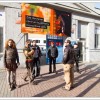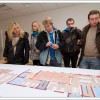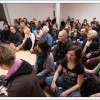Development of Interest in Buddhism in the Czech Republic (1)
Jitka Cirklová
Charles University of Prague
Faculty of Social Science
Department of Sociology
U Kříže 8
158 00 Praha 5 – Jinonice
Czech Republic
jitkacirklova@yahoo.com
Buddhism has been a subject of study for
scholars of Indology, religious studies, theology, or sinology at the
Czech universities since the end of the nineteenth century. But until
the 1990s, there were fewer Buddhist centres on the Czech Buddhist scene
than individual Buddhists. The early period of development of interest
in Buddhism was influenced by the national perception of the Catholic
Church as the church of the Hapsburg empire. After Czechoslovakia
gained independence from the Hapsburg monarchy in 1918, Czech
intellectuals viewed Buddhism as an individual spiritual pilgrimage,
which they preferred to passive membership in rigidly hierarchical
religious institutions and churches (Rozehnalova, 2008), and
consequently the practice of individual meditation became popular among
thinkers and intellectuals.
Many well-known historical personalities
influenced the formation of the Czech Buddhist scene. František
Drtikol, an art photographer and painter, translated some basic texts
of Mahaayaana Buddhism for his own use and for a group of his
disciples. In his practice of meditation he combined different
directions and schools. Kvetoslav Minařík, also a teacher of
meditation, wrote many texts to popularize Buddhist ideas, aiming to
disseminate Buddhism in a European and Christian context.
From the 1970s until the end of the
1990s, academic texts were used and studied in Czech Buddhist circles;
an example worth mentioning is the book Buddha (a biography of
Buddha) published by the philosopher Egon Bondy in 1968. It was the
only book on Buddhism published under the Communist regime. These texts
point to the fact that, even before centres were set up, Buddhism in
Czechoslovakia engaged the interest of a certain circle of thinkers,
yoga instructors, academics and artists, even though the boom of
interest in Eastern thought of the 1960s and the 1970s largely passed
the Czechs by.
In the Czech Republic the first
meditation groups started to emerge in the 1990s. According to Baumann
(2001: 18) this is the period in which centres emerged throughout
Western Europe. Baumann states (ibid.) that more than 60 per cent of
the Buddhist centres in the West have been founded within the last
twelve years, and that these represent more than the total number of
centres established within the first eighty-five years of the twentieth
century. This supports the assumption that the establishment of centres
in the Czech Republic was not due only to the social changes that took
place there. Moreover, it would be simplistic to associate developments
in the Czech Republic only with the social changes that took place in
1989. In 1990 only fourteen meditation groups existed; in 2007 there
were fifty-seven active centres (Buddhanet.net). It is also worth
comparing the number of centres in the Czech Republic (fifty-seven
centres in a population of 10.3 million), with that in countries such
as Ireland (twenty-six centres in a population of 4.2 million), Poland
(eighty-four centres in a population of 38.1 million) and Slovakia
(twelve centres in a population of 5.3 million), all of which are
countries in which traditional religion – in their case the Catholic
Church – has a significantly stronger social impact than in the Czech
Republic, which is by contrast one of the least religious countries in
Europe. I would suggest that the widespread secularism in the Czech
Republic helped the expansion of Buddhism. This corresponds with the
“strictness” hypothesis that Wuthnow (2004: 366) presents in his
article. He concludes that Buddhism is more attractive to people who are
not affiliated to another religion. The strict belief system of some
churches functions, according to Wuthnow, as a barrier to the rate and
extent of the spread of Buddhist teaching in a social setting. He
extends this hypothesis by suggesting that the teachings of Buddhism are
more attractive to those who, though not already affiliated to a
religion, are searching for some ethical framework or for certainty
about an afterlife (Wuthnow, 2004).
After the Velvet Revolution in 1989,
Buddhism appeared also on the Czech political scene. Czech intellectuals
felt an affinity between Buddhist and humanist ideals, and sought to
sympathize with the “oppressed” Tibetan nation. In 1989, the
Czechoslovak president Václav Havel was the first head of any European
state to invite and receive the Dalai Lama in a celebration of human
freedom and the end of the totalitarian regime (Batchelor, 1994, xvi).
From the 1990s until very recently, a number of Czech politicians have
continued to show public support to Tibet. Buddhism began to be
presented by the media and perceived by Czech society as a variant of a
universal humanistic philosophy of human rights and equality. The
media picture of Buddhism in the Czech Republic as well as in other
European countries was (and to some degree still is) influenced by the
nineteenth-century European intellectual stress on the rational and
pragmatic aspect of Buddhist thought, and on its universal humanist
values in harmony with science, in contrast with religions based on
revelation and dogma (Baumann, 2001). In the presentation of Buddhism in
Czech society we can also trace the notion of “Protestant Buddhism”
(Baumann, 1997), which emphasizes personal responsibility and moral
autonomy, and rejects ritualism.
Mapping the Form of Buddhism in the Czech Republic – Outlining the Methodology of the Research
The goal of this phase of my doctoral
research was to determine which lines of Buddhism are active in the
Czech Republic, and whether these groups emerged autonomously in the
local environment rather than being a part of the global network of
Buddhist organizations operating in Europe and the US. A questionnaire
comprising thirteen questions dealing with different subjects was sent
to all eighty-seven centres listed on the Internet. Of the eighty-seven
questionnaires sent out, ten of them (11.5 per cent) were returned as
undeliverable, and a further twenty centres (23 per cent) failed to
reply even after a repeated mailing. Thus fifty-seven centres (65.5 per
cent), representing different schools of Buddhism, participated. It
is possible to say that the character of Buddhism represented in the
Czech Republic corresponds to that of Buddhist schools in other
European countries, where Tibetan Buddhism is also the variety
represented most often (Lenoir, 1999).
The majority of Buddhist centres in the
Czech Republic follow the lines of global Buddhism. One of these is the
“Diamond Way” Buddhism of the Karma Kagju lineage, registered with the
Czech Ministry of Culture in June 2007 as a religious association or
church. With the growth of Diamond Way Buddhist centres, local
meditation groups have emerged, belonging to the same Buddhist stream
of the Kagju lineage. However, for various reasons, they are unwilling
to be members of this global Buddhist organization. In addition, there
are local groups practising engaged Buddhism. In the case of Theravada
Buddhism, there is a marked tendency to work directly with spiritual
teachers and organizations from Asian countries rather than to
co-operate with Western centres.
In each centre that responded in the
Czech Republic we can identify different degrees of activity among the
participants and sympathizers, from “active” to “anonymous” or
“passive”. Tweed (1999) introduced the term “dharma-shoppers”
to designate those who do not take an active part in any particular
Buddhist community, but are influenced by the public and media
presentation of Buddhism. My respondents also indicated that besides
the reported number of active members (1,547 in all the participating
centres) there can be traced a group of persons characterized by the
respondents as “meditating”, “sympathizing” or “co-operating”, and
their number in some cases exceeds the number of those attending
regularly. To this peripheral group also belong the remaining 7,000
people who registered as Buddhists in the population census in 2001.
Furthermore, according to the records of
the Czech-Vietnamese Society in the Czech Republic, there are more
than 55,000 Vietnamese immigrants legally resident in the country, 90
per cent of whom are Buddhists. Obtaining Czech citizenship is a lengthy
process which can take decades, and therefore these Buddhists do not
appear in the population census records. Nevertheless we can expect some
changes as the first generation of Czech citizens of Vietnamese
background comes to age. In 2008, the first Buddhist temple in the
country was opened in the town of Varnsdorf by the Vietnamese
community. Like in many othere countries, the Buddhist communities of
Czech converts and of Vietnamese immigrants have separate practices,
because the Vietnamese Buddhist temples also serve cultural and
educational needs other than spiritual ones.
In Buddhist centres established by Czech
converts, occasional events are preferred to regular weekly meetings
by all groups. Such occasional, but intense, activities are designed to
help and develop individual spiritual practice. Buddhist centres are
not perceived as temples or as hubs of the community, but as centres
of information. This corresponds to the activities they offer,
providing instructions for the practice of meditation, and information
about Buddhist doctrines. The centres also present their activities to
new adherents in strictly informational terms. Despite the evident
efforts made by all centres to appeal to outsiders, all respondents
reported that they do not actively aim at recruiting new members. These
findings correspond with the analysis of Obadia (2001: 96), of the
intellectual resistance to the term “mission” in referring to the
spread of Buddhism in the West.
The age range of the Czech Buddhist groups proved to be
different from the average age reported in polls in European countries
and the United States (Smith 2007, Henry 2006). The age range (80 per
cent of answers) in the Czech Republic is between twenty-five and
thirty-five. Smith (2007:313) conducted a survey of the American
Buddhist Organizations, where he found that the most frequently
declared age of its members (60.3 per cent of all responses) fell within
the range of forty to fifty-nine. Smith (2007: 313) shows that the
youngest respondents in the US range between twenty and thirty-nine,
but this represents only 10 per cent of the responses he received. A
similar study carried out in the UK showed the most frequently
indicated average age of members as forty-eight (Henry 2006: 12). When
we compare the average ages of members with the division of time
reported by each centre between meditation and lectures, we can see
that the lower age range of Czech Buddhists (twenty-five to thirty)
prefers less meditation and more lectures on Buddhism or other
activities.
Besides their age ranges, particular
communities are characterized by the proportional representation of men
and women. An analysis published by the Czech Statistical Office (CSO),
“Compositions of population by religion, gender and by age”
(www.czso.cz), states that women represent 56.7 per cent of all
believers, and that women predominate in established traditional
churches. Also according to the CSO data, in most of the “new”
religions the proportion is reversed: more men than women adhere to
Islam, Buddhism and Hinduism. My findings correspond with the data of
the CSO, reporting a majority of male members of Buddhist groups. A
more specific division taking the type of Buddhism into account
suggests trends in which women and men prefer particular Buddhist lines:
in descending sequencing, the results show that the choice depends on
the extent of the social engagement of the groups and on the techniques
employed for meditation.
On the basis of data previously
recorded, I infer that women are more active in groups which are
socially engaged to a greater degree. Groups with a higher
representation of women (e.g. Tibetan Buddhist groups, with 52 per cent
of women, Socially Engaged Buddhism and Diamond Way Buddhism, with 47
per cent) seek to locate Buddhism in the cultural context of the West;
their primary focus is not only to provide guidelines for individual
spiritual experience, but also to concentrate on social engagement –
whether at a local level (for example, organizing exhibitions and
workshops on Buddhism) or at a global level (for example, human rights
issues in countries such as Tibet and Burma). Furthermore, they are
active in specific charitable projects (such as organizing
long-distance adoptions, or setting up Buddhist kindergartens in Sri
Lanka). By contrast, in schools of Buddhism such as Theravada (32 per
cent women) or Zen (Kwan Um Zen 41 per cent, Soto Zen 25 per cent
women), women form a minority in both of these groups, although in Zen
schools women hold senior positions both in local groups and in the
national Sangha leadership. Why there is such a division between women
and men in the Czech Republic would require further qualitative
research in the field.
Social Engagement and Non-Engagement, and Spiritual Orientation, of Buddhism in the Czech Republic
In Western Europe social commitment quite significantly
affects the form of the Buddhism presented in Western Europe. For this
reason, the questionnaire included a question about the areas in which
Czech centres are active. Unless groups are established primarily for
engaging in human rights issues in Tibet or Burma, a very low degree of
social activities is a common feature for all the Buddhist groups
studied. From the responses it is very clear that each group has an
interest in increasing the number of its centres; publishing was often
mentioned. Participation in inter-religious dialogue was mentioned in
only two cases. Buddhism in the Czech cultural setting, therefore,
cannot be defined as engaged Buddhism, as it makes no attempt to engage
with the environment outside its centres.
Although centres do not always present
themselves as religious, it can be concluded that all of them focus
primarily on spiritual practice, carrying out activities that the
members perceive as religious rituals. The respondents perceive the
recitation of Buddhist texts and mantras, and in some cases
meditation, as religious rituals. Different Buddhist schools and
directions are not combined in Czech centres, nor is Buddhism combined
with any other spiritual practices. According to their responses, the
members see the present fixed form of Buddhist thought in a very
positive light as they prefer to be labeled as Buddhists and not
followers of some form of a New Age amorphous movement.
Conclusion
In the Czech Republic Buddhism is becoming the object of
interest to a growing number of people who have created groups for
meditation. Also it has become subject to a process of
institutionalization, as one of the Buddhist groups (Diamond Way
Buddhism) has been registered by the state, and has the same legal
status as traditional churches. The evolution of a Buddhist group into a
centre for meditation and then into a state-registered religious
association enables us to understand the ways in which contemporary
religious groups are formed and differentiated, with their members
actively taking part in shaping their own forms of religious character
and practice. Despite their fluid organization, some characteristics of
local Buddhist groups can be established on the basis of available
studies. Their age range is significantly lower than that of groups in
other countries, they exhibit a substantially lower rate of social
engagement, and their focus is on purely religious and spiritual
activities. It is also clear that their members are aware of the
different characteristics offered by specific directions.
(1) This article is based on research
undertaken within the research plan of MSM 0021620841 “Czech Society
Development within the EU: Challenges and Risks” at the Faculty of
Social Science of the Charles University in Prague.
References:
Batchelor, Stephen. 1994. The Awakening of the West. The Encounter of Buddhism and Western Culture. Parallax Press, Berkeley, California, pp. xv-xvi.
Baumann, Martin. 1997. “Culture Contact
and Valuation: Early German Buddhists and the Creation of a ‘Buddhism
in Protestant Shape’”. Numen, Vol. 44, No. 3, (Sep. 1997) pp. 280-281.
Baumann, Martin. 2001. “Global Buddhism: Developmental Periods, Regional Histories, and New Analytical Perspectives”. Journal of Global Buddhism, pp. 1- 43.
Buddhist information and education network. www.buddhanet.net .
The Czech Statistical Office, Český statistický úřad. http://www.czso.cz/csu/2003edicniplan.nsf/o/4110-03-skladba_obyvatelstva_podle_nabozenskeho_vyznani,_pohlavi_a_podle_veku .
The Czech-Vietnamese Society, Česko-Vietnamská společnost Praha, www.cvs-praha.cz.
Henry, Phil. 2006. ¨The Sociological
Implications for Contemporary Buddhism in the United Kingdom: Socially
Engaged Buddhism, a Case Study¨. Journal of Buddhist Ethics, Vol. 13.
Lenoir, Frederic. 1999. Setkání Buddhismu se Západem. (Czech translation) Volvox Globator, pp. 9-37, 169.
Obadia, Lionel. 2001. ¨Tibetan Buddhism in France: A Missionary Religion? ¨ Journal of Global Buddhism, Vol. 2, pp. 92-123.
Rozehnalová, Jana. 2008. ¨Czech Perspectives on Buddhism, 1860-1989¨, Journal of Religion in Europe, Vol. 1, pp. 159, 160.
Smith, Buster G., 2007. ¨Research Note, Variety in the Sangha: A Survey of Buddhist Organizations in America. ¨ Review of Religious Research, Vol. 48 (3): p. 313.
Tweed, Thomas. 1999. Nightstand Buddhists and Other Creatures: Sympathizers, Adherents, and the Study of Religion. In American Buddhism, Methods and Findings in Recent Scholarship, edited by D. R. Williams and C. Queen. Richmond, UK: Curzon Press, p. 71-90.
Wuthnow, Robert. 2004. ¨Buddhists and Buddhism in the United States: The Scope of Influence. ¨ Journal for the Scientific Study of Religion, Vol. 43 (3), p. 366.



 Czech
Czech

























Chinese Buddhists | 02:17:12 05:50pm
Your synopsis about Buddhism in China is like so many other
English-language sites in that it briefly mentions the history of
Buddhism in China. To your credit you do mention that Buddhism is
practiced even today in mainland China. Buddhism (and especially
Chinese Buddhism) is actually thriving today in mainland China. The PRC
is in fact the largest Buddhist country in the world; and depending on
estimates of how many practitioners there are in China, Buddhism may be
the third largest religion in the world after Christianity and Islam.
Like pre 1949 China, most “Buddhists” in China have not taken formal
refuge in the Triple Gem (Buddha, Dharma and Sangha); this was also the
situation in Taiwan until relatively recently (post 1980s); and many
Chinese Buddhists also follow Daoism(however this was also the situation
in historical India where many Buddhists also practiced Hinduism. )
Nevertheless the building of some of the largest statues of Buddhas and
Bodhisattvas in the world on the mainland, hints at the popularity of
Buddhism in mainland China. Mount Wutai is the most popular tourist
site in Shanxi. This also suggests the immense popularity of Buddhism
within mainland China.
Thedude | 12:11:10 04:27am
That was the biggest wall of text EVER.
kishan | 10:10:09 09:56am
I borne in 1956 and not seen the independence of India or other
things. I visited all parts of India and not visited aboard, Hence the
following details are of India.
FACTS TO SAVE & EDUCATE A CHILD
(1) Child Study in Schools than Colleges / Universities General studies
to earn for a good Life.
(2) After study the life moves for earning for life and marriage take
place:
(a) Both are in service / working is very good but educational
crime is harmful.
(b) Only husband is working but housewife should apply her mind so
nobody can misguide her & take the
Benefit by slaughtered husband / others. Even second / third
/ numbers of marriages is harmful for kids
(c) If the wife is misguided & become a member of the group
who are thirsty for blood of males are
harmful for herself and others. Group will with them &
she have to work for them finally kill her also.
(d) Everybody should be educated as well as a child in such way
for right work / thinking & a simple
education of Sashtra’s / Ethics as well as politics / law
known by everybody to save a child.
(e) Differences between Criminals & their team or how team
works who are thirsty for blood of
males. People can ask their educators’ / guru how we should
do a good work for children.
Page No.24 (18th line) To-day the Education given to females is not
good. We should give progressive &
truth education and it is not only
from the books.
Page No.68 (12th line) If we think & ask them, they have nine lives
in INDIA like Cats and boys are dying like
houseflies.
Above written in Hindi Book —— Bhartiya
Nari
Written by Swami
Vivekananda
This is the reason that INDIAN SAINTS don’t marry
Wife is so kind to her Criminal Guru / Educator
Both are thirsty for blood of males & People are slaughtered in
remote areas
POSTMORTEM OF EDUCATION
CRIME BASED ON EDUCATION OF SHASTRAS’ / ETHICS
At present crime done by illiterate persons are criminals & other /
above crime are literate crime which is done under the word God /
religion based on education of shastra’s / ethics as well as politics.
Why the word God & other words like Brahma, Bishnu, Mahesh, Atma,
Permatma, Deowata (Man), Devias’ (Females) etc. in Hindi are there, it
can be simplified by educators of Shastras’, by competitions in schools
for child & have smooth life free from obstructions or hurdles for
developments. Agricultural farmers or their females give us food &
GOD can be seen in them directly. Think that who will die for kids, then
among those people, the persons who love & want to save kids should
think & educate children in schools weather a Boy or Girl. The day
people will think for children about the educational crime and it can be
simplified / finished for children by educated persons by theory with
practical.
3. In my views “How to identify peoples by religion or country wise???
And there are four types
of thinking / working in humans / alive things & if we take
from lower side they are as under;-
a. Thinking / working like animals as they kill or eat small animals
weather example of monkey or Cat & Rat
or Goat etc. Here can you think for child weather a Boy or Girl.
b. Thinking like humans, take birth & die without creative work
or dead thinking for children.
c. Thinking like doctors who learn, by studying always from or on
animals and dead bodies to think better
medicine basic to powerful / best medicine to save others &
developments.
People are benefited by their education & mind.
d. Thinking like sciencetists who learn, by studying always from or
on animals to add better / best facilities.
e. Can you or your associates interact and suggest some better way
or internet site to do it in Better way?
Please think like doctors and sciencetists for children’s Education. At
present I am writing about the group who is involved in murder of Indira
Gandhi & Rajiv Gandhi former PM of INDIA.
A Specialized school may think always about best future of children /
others with the interactions of other schools & children in all
areas like other activities. Not 1 or 2 may be 5000 or more students and
teachers always can think & ask / discuss this in Schools as a
supreme power to save a child from educational crime. This school may be
managed in all country or by all people for world or everybody from
donation of Rs.1/= or as required.
Homosexual Society
World should support if they are faithful to their children & please
don’t write books, do this good / God work to save children through
schools / children and their associates. Children after study also can
do & choose good work / thinking & do something to save
children. Saints and more intelligent version are homosexuals society
don’t marry & don’t misguide others. This may be a best association
of the World. Sex is a part / work of body as example if we do urine
from urinal, if leg is used for walking; hand is used for right work
etc. Hence you think in a right way, this is a family / society without
corruption & right work for children. In the World all religion has
females & males. How to identify peoples by religion or country
wise??? Why all these religion has been created?????
Think how a person think good up till death for betterment in all fields
or a person can choose one field to reach to the best by interactions
and adopting good / better suggestion / things of others to reach at the
best by debate / competitions and select better / best ideas. Please
don’t oppose to stop your thinking and thinking should be better like
agricultural farmer / doctors & sciencetists etc. World’s people can
utilize their some money / mind / time etc. to educate & save
children weather a boy or girl from wrong educators of females who are
thirsty of blood of males.
Children may be saved / educated by taking side of female even when they
are wrong and can be told to boy, why he is involved with female. This
may be done at all stages from the birth and People can be challenged
not to marry in any case (criminal / good / god) and don’t birth a baby.
Children can be educated not to go in remote areas with any body.
World should be full of thinking like Swami Vivekananda & Buddha
because they give education on truth / developments. What is the
specialty of IIM or why it is one of the best? We manage a small
enterprise and solve the problem in right way which comes on the way
that is a Management skill without IIM Certificate and IIM certificate
is a Proof that mind is intelligent or capable to think always better.
Is this true? Please think about children. Should we adopt better things
of others? Explore everywhere what we have done good to boosts others
to think better / best.
True use of sciencetists products & their mind
(1) Why condom is produced & the true use of it
(a) Away from all diseases and all corruptions by not involving in
intercourse, thus saints and more intelligent version are homosexuals
society don’t marry & not misguide others.
(b) In case of marriage don’t put your nuclear drops inside while doing
sex & create problem for own self or for a coming baby in this
World.
(c) Away from unknown diseases / virus of inside.
(d) By this you will be not treated as a Rat or Goat or monkey etc.
(2) Why Viagra is produced & how it can be better.
(a) It can be used while sex so feeling can be more satisfaction in
depth
(b) It can be made better like sex in dogs.
(c) It can be maximum largest can be seen from one side to another side
out for wrong educator’s, who are thirsty for blood of males.
(3) Can Robert fulfill this problem and a child can be saved /
educated in right way???
(4) Please think like doctors and sciencetists for children’s
Education.
(5) Save a child by challenging, two words like in Hindi Rawani or
Thirsty for blood of man are means same;
a. Never marry to a man weather criminal / good / god or reverse, don’t
give birth of baby or a male baby to be slaughtered in remote areas as
animal like Goat or Rat.
b. People / females sought for betterment of females should think &
do betterment of all females and advice everybody don’t give birth of
baby or a male baby & don’t harm them.
WHY BETTERMENT OF FEMALES IS ONLY IN VOICE?????
(6) I think educated person should do good work & earn as much as he
can and Spend / think for interactions to save world’s children. Once
it is implemented to save a child from the group who is thirsty for
blood of males by simplified education of Shastra’s / Ethics or
crimeless World.
RESERVATIONS & DEVELOPMENTS
Reservation to females must be more than 100% everywhere and children
should be educated in schools how not to be slaughtered by a female who
is thirsty for blood of males or their wrong educator’s who are thirsty
for blood of males. Reservation to agricultural farmers or their females
should be more than 50% as they give us food by their hard work through
out their life to everybody and GOD can be seen in them directly as
they don’t think & do any harm anybody. Females from lower income
group should get 30% reservation, these people have no time & mind
to think negative or bad things and 20% reservation to females from
group of teachers who can think & educate in right direction only.
Educated persons do not need reservation and should do good work.
Finally everybody can think as everybody has mind and capacity to think
always to do better / best work and kids can be saved from the group who
is thirsty for blood of males. World should be full of thinking like
Swami Vivekananda & Buddha because they give education on truth /
developments.
Think about a child, whether one boy or girl is there on one side and
rest world is on other side, think that who will die for kids, then
among those people, should think & educate children in schools. Life
should be free from obstructions or hurdles for developments by study
of theory and practical by adopting better things of others.
Wife is so kind to her Specialized Educator
Both are thirsty for blood of males & People are slaughtered in
remote areas
Why people sought for Ram / Krishna scared to be Truth Education for
kids of SHIVA
SAVE / EDUCATE CHILDREN
KISHAN JALAN
KISHAN JALAN
C/o Hiralal Bhagwati Prasad
12/2 Sobharam Baisakh Street
Upper Bazar, Ranchi - 834 001
Kolkata - 700 007
Ph: 0651-2200166 # 2203279 Mob:0 98318 22701
Ph:033-22597321 # 22597429